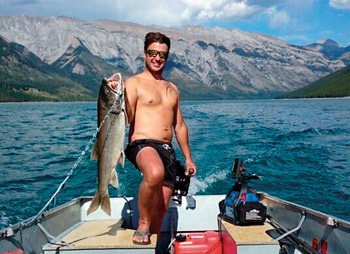|
 |
 |
In the late summer, big trout in Minnewanka Lake, Banff, Alberta, are typically found in deep water. The smaller ones school in 40- to 60-feet right up the middle of the lake with the larger ones chasing them. Trout eat trout, so typically you will see ones of the same size hanging out together with the odd larger one chasing them around for a meal.
The first day you get to any new lake, I recommend that you spend the time scouting out the features of the lake to find where the fish are holding. My partner and fishing companion, Noelle, and I rented a 13-foot aluminum boat from the place at the beach. It had minimal power and only went 3 to 5 knots. We set out to scout the lake for fish.
 |
Lake Minnewanka is 21 kilometres (13 mi) long
and 142 metres (466 ft) deep. |
You can spend the entire day fishing in a lake full of fish in the wrong spot or the wrong lure and you won’t catch anything. As such, I had picked up an inexpensive (~$350) portable Lowrance sonar to locate the fish and a battery source to power it from Canadian Tire. I went for the one with DownScan technology with overlay option. It provides a much clearer vision of the structures on the bottom of the lake and shows you where the fish are holding. It also has GPS so that you can mark and return to the location you find fish.
Many people do not take the time to learn how to tune the sonar, which results in minimal performance and minimal success. I used a combination of the online manual and YouTube reviews to find the optimal settings for the sonar. I set up a deep-water sonar setting with 83 mHz and a shallow water 200 mHz setting. The 200 mHz has a shorter wavelength and therefore provides higher resolution at shallower depths. It has trouble penetrating through lots of water and this is why a longer wavelength should be used in deep water. When switching between the two, I was able to see fish in deep water that I could not otherwise see.
It is important to use the tools you have bought, namely, tuning your sounder correctly. This makes a world of difference to the performance of your machine and the success of your fishing trip. I spent a few days prior to our trip looking at all the settings and getting comfortable with them. That way, I could operate it without any difficulty.
I had two rods set up in the boat; one rod was for trolling, with a three-way swivel containing a weight and flasher, followed by a 3- to 5-inch bait. The second rod was a mooching/spinning rod set up with a 5-inch silver and pink buzz bomb. This way, I could switch between two modes of fishing on the fly.
To have a chance at catching big fish, you need to study the body of water, understand how the fish are behaving and where they are holding, based on the time of the year. This sounds hard but it is not. All you need to do is a little research. Use the Internet, as there are countless fishing blogs and reviews on most bodies of water. You will find tips and tricks and where the fish are likely to be found. Also, use your knowledge of the type of fish you are after, it’s habits, and apply that to your fishing.
Another valuable action would be to make a trip to the local fishing expert. Stores such as Cabela’s and your favourite Fishin’ Hole store offer some great advice. The guys with all the gear will be able to give you a few handy secrets and may even pass on their favourite bait/lure to you. I got the buzz bomb and sonar I used to catch this fish from the specialist at the store. I read online that fishing for trout in late season is a game of precision and delivery. They are only located in specific areas and will only take certain bait/lure presentations.
When Noelle and I set out scouting the lake for fish, I noticed that there were fish holding at the bottom in 280- to 210-feet of water in specific spots around the lake. It was difficult to make a size determination at that depth, as they were lying right on the bottom. Based on what I had read about their behaviour, I ascertained that they were likely the larger, older trout in the lake that we were looking for. The challenge was that the wind made it difficult to stay on the desired spot while descending a line to depth. We kept drifting out of position. In response to the wind factor, we decided instead to spend the day trolling around searching for fish. We had large flashers and lures that would go through schools of trout with no luck. We only had one small bite on the trolling rod.
After the day, I ascertained that my lure was too big for most of the trout we were seeing on the screen. I had chosen a larger setup to try to land a larger fish. However, we may have had more action with smaller flashers and lures. That is truly the angler’s paradox. Do you sacrifice a good day of fishing smaller fish for the opportunity to catch the big one, or do you sway to produce more numbers over size? Since hindsight is 20-20, I would downsize the trolling rod hardware to try to get more action, while keeping the mooching rod setup the same.
The following day, the wind relented. We now had the opportunity to fish for those elusive trout holding in 200-feet of water. They evaded us the previous day due to excessive wind and drifting. This day was perfect. We marveled at the bluebird-like sky and majestic mountains reflecting off the glass-like surface of the pristine lake. I was thankful just to have this breathtaking experience, to be part of this untouched wilderness. I sat there motionless, captivated by the awesome tranquility that engulfed me. A pronounced spiritual moment overtook me. Indeed, it was the ideal surroundings to do some soul searching and converse about life with my partner, Noelle. We took a few moments to reflect on our thoughts and to absorb nature’s wondrous beauty.
We then motored down to the spots we marked on the sonar the previous day and where we were seeing many fish. The sonar fish alarm was going wild but we did not manage to pull any in. We circled the schools of fish until the sonar GPS map looked like a whirlpool drawn on it. Eventually, we began making our way back up the middle of the lake, as we were approaching the end of the day. I was still feeling very spiritual due to the sheer beauty of the afternoon. I reminisced about my grandfather who had passed on and remembered how much he would have liked this moment too. Immediately, I began to notice something.
 |
The author had to land the fish by hand,
as it was too big for his net. |
We were just below the spectacular mountain cliff on the south side of the lake when I spotted the three fish on the bottom in 200-feet of water. I hit the motor kill switch and left my trolling line be, as I threw the buzz bomb over the side. Noelle began to reel in the trolling line, as I allowed my lure to drop. At 20-feet off the bottom, or so, I closed the bale and allowed the line to return to a vertical position. I then opened the bale and dropped it to the bottom. Then I pulled it up off the bottom and paused before dropping it again. When I pulled it up once more, the fish took it softly. I set the hook and it took off! I told Noelle I had a fish on and she responded with excitement. She finished reeling in the trolling line and moved to the front of the boat to get her camera.
The fish went for three big runs where all I could do was hold on and let the drag do the work. The drag was set so the fish could only pull it out when it was giving 100-percent effort. At 85 percent, it could no longer pull the line off with such ease. In between runs, I tried to get as much line back as possible and quickly pull the fish to the surface to have the best chance of landing it. I would pull up on the rod, and reel in the slack on the way down as my fishing hero, Robson Green, had demonstrated so many times before. Though I hadn’t caught a fish in the day and a half that I had been on the lake, I did have my drag set perfectly. This allowed me to play the 35-pound fish on 12-pound line without having to take a break and adjust the setting. I realized that another great strategy is to play the environment against the fish as best you can. The warmer water on the surface slowed the fish down, made it easier to play, as it tired and became lethargic.
When we were getting close to the fish, I could see the 12-pound mono leader I had tied on to my braided line. We both stood there looking into the water, transfixed. Noelle put on my polarized sunglasses and she was the first to spot the monstrosity in the water. Her reaction was priceless, as she was so shocked. I had 100% adrenaline coursing through my veins, as I caught the first glimpse of what I thought was some sort of sturgeon based on its sheer size. As it got closer, I realized that, in fact, it was a monster lake trout!
 |
| The author with his huge Lake Minnewanka lake trout. |
Panicked, I directed Noelle to grab the net knowing full well that sometimes you only get one chance to land a fish like this. Botched surface handling can result in the fish spitting the lure. As the fish approached the boat, I directed it toward the net. I realized right away that not only would the head not fit in the net, the net was also far too small! I was going to have to land it by hand!
I pulled the fish over to the side of the boat and gave the rod to Noelle. I attempted to grab the trout by the gill plate to pull it into the boat. I had to be careful because the centimetre long razor sharp teeth are located inside the gills. If this fish started thrashing, I would be going to the hospital. I failed on the first two attempts, as I was unable to get a perfect grip and was worried about being maimed. At that time, I had a flashback to Ernest Hemingway’s story about the Old Man and the Sea, wondering how this all would turn out.
At one point, the monster fish turned outward and the line was slack. I could see the hook just dangling on the edge of its mouth, ready to spit out. I thought all was lost. I reoriented the fish by grabbing the line and got the grip I needed. I had to hold on and lean back to drag it into the boat.
The second that the fish hit the bottom of the boat, I had to sit down to catch my breath. I had so much adrenaline pulsing through me I thought I was going to have a heart attack! I sat down, grabbed my chest, and looked on in amazement. I tried to get up and move about, but my whole body was still trembling from the adrenaline. Noelle captured the moment of triumph in a photograph. Amazing! ■
For previous Reader Stories click here.
|
|
|
|


